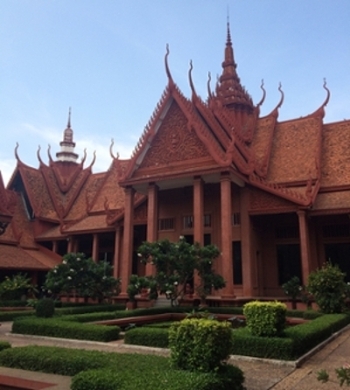Exploring and Making Connections
Before this week it had been nearly fifteen years since I had ridden a bicycle. I soon found that the expression “it’s like riding a bike” is highly inaccurate, at least when applied to me. Knowing it was probably a mistake, I bought the bike anyway. The only viable alternative form of transportation is a tuk-tuk, which is not only expensive, but also means dependence on someone else and it would always make me feel like a tourist. Being able to get where I want to go and when I want to go there is an important part of feeling like I’m living in this city, however briefly.
So every day this week I commuted to and from work and ventured out for dinner on my bike in anxiety. Yet the week passed without incident. As I was feeling more confident on the bicycle, I decided to test myself by exploring this weekend.

On Saturday I rode over to the National Museum of Cambodia, a breathtaking building that houses a collection of statutes, tablets, sculptures, and reliefs from the sixth to twentieth centuries. Nearly all of the antiquities related to Buddhism, progressing from representations of Vishnu and Shiva to Gautama Buddha. The collection shifts drastically in the 18th and 19th centuries, displaying agricultural tools, weaponry, a loom, theater jewelry, and paintings. Unfortunately, I am largely uninformed about Buddhism, so I’m afraid I couldn’t fully appreciate the collection. However, I bought a book on the subject as I was leaving the museum and plan to return with more context to guide me.
Sunday I pushed my boundaries even further, taking a biking trip out in the countryside (where I promptly fell into some mud and fertilizer; fortunately the river was nearby). After a quick ferry trip across the junction of the Tonle Sap and Mekong Rivers, we were in Kandal Province, a completely different world from Phnom Penh. Small boathouses bobbed on the river, while homes on stilts rose above them on the shore. After riding through a village of very tiny streets and elevated homes and stores, we were soon in the middle of nowhere. The thin and bumpy dirt road passed by a mixture of agricultural land, one or two room shacks on stilts, and enormous, garish villas, perhaps a sign that soon the abundant construction in Phnom Penh would creep across the river.
The guide seemed to be thinking along the same lines. He said that soon the countryside would be developed, and “the people there [would] be happy.” Considering that my work here involves researching land issues, I was inclined to disagree. Land rights in Cambodia are fragile and disputes are common. There are no property records dating before 1979, the work of the Khmer Rouge regime which forced the Cambodian population to live in agricultural collectives during its nearly four-years of governance. It wasn’t until the late 1980s that the concept of private property began to be reintroduced, and the right to own land as a private individual was formally reinstated in the 1993 Constitution. Even then, the legal framework detailing those rights remained nonexistent until the Land Law was passed in 2001, and land registration is still ongoing. The result is that small landholders can be pushed off of their land, often without compensation or for compensation far below value.
Sitting in an office and researching on a computer all day, it is not always easy to experience a meaningful or personal connection to the issues I learn and write about. The statistics, articles, and reports, though important and moving in their own way, are impersonal. In visiting places that have been or someday could be sites of disputes that I read about, the realities of those issues and the people they affect are apparent and unavoidable. It's through associating the abstract concepts I research on a daily basis and the tangible people and places I visit that I can connect to the work I am doing.